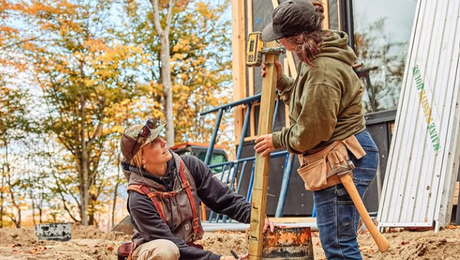
Dear Mr. President,
Congratulations on your remarkable and historic election to the most powerful position on earth. The challenges you face are tremendous. They may, indeed, feel overwhelming, with our nation engaged in two wars, with the economy seemingly in free fall, with unemployment soaring, and with global climate change threatening the very planet on which we live. Given all this, houses might not seem a top priority. But in fact, our homes are central to the multipronged efforts needed to fix our country.
For too long, we’ve failed to make explicit connections between the challenging problems we face. Economic recovery, national security, energy independence, and environmental protection can all be addressed with integrated solutions, providing tremendous win-win opportunities. Your Homeland Security Department should be pushing for dramatic improvements in the energy performance of our houses because low-energy homes are more resilient to interruptions in power and heating fuel. Retrofitting existing homes to boost energy performance will create millions of jobs, and by cutting energy use, we will reduce carbon emissions—a key environmental priority for us and, more important, for our children and grandchildren. As you lay out priorities for your administration, please consider the following suggestions.
Fix existing homes and put people to work by establishing an Environmental Service Corps.
Along with putting hundreds of thousands of people back to work in the 1930s, the Civilian Conservation Corps addressed environmental problems such as soil erosion and deforestation. The same model can be applied to today’s problems. An Environmental Service Corps should be created to put people to work while delivering energy security to our nation and mitigating the effects of global warming. The Environmental Service Corps should be the cornerstone of a new public-service agenda that will give Americans an option besides the military to serve our country.
The leading program of the Environmental Service Corps should be a massive effort to superinsulate America’s low-income housing. A workforce of several hundred thousand people, trained and led by professional builders, remodeling contractors, and weatherization specialists, would carry out extensive energy retrofits to reduce the energy consumption of low-income homes and apartment buildings by one-half to two-thirds.
In coastal areas, the Environmental Service Corps would perform ecological restoration to help protect land from storm surges. Elsewhere, teams would carry out invasive-species control and even reforestation to help our forests adapt to rapid climate change.
Use tax credits, loan guarantees, and other vehicles to encourage middle-class homeowners to improve the performance of their homes.
While public-works programs can tackle low-income homes, different programs are needed for middle-class homeowners. To reduce the total energy consumption of their homes by one-half to two-thirds (a challenging but realistic goal), a variety of tax credits, deductions, loan guarantees, and other inducements will be needed.
We need new incentives that are performance-based, unlike most of today’s tax credits. By basing subsidies directly on improvements in energy performance—not simply on how much money is spent—we can encourage energy-conservation retrofits and renewable energy systems that provide an attractive return on investment.
A performance-based focus could also apply to mortgage subsidies and loan guarantees—perhaps using the home-energy rating system (HERS). This is a 0-to-100 scale in which 100 equals the energy performance of a home meeting the 2004 Model Energy Code and 0 represents a net-zero-energy home. If the secondary-mortgage market required a HERS index of 25 for new homes and 50 for existing homes, we would see a dramatic ramping up of energy performance.
So that our homes can be powered—and even heated—using clean, renewable-energy sources, we should encourage rapid commercial investment in large wind-power and solar-power systems. We can do this by increasing the production tax credit to 2.5¢ per kilowatt hour (kwh) and enacting that tax credit for a full 10 years. This production tax credit, which has been renewed on a haphazard, year-to-year basis with occasional lapses, encourages investment in renewable-electricity production by providing the electricity producer with a tax credit tied to actual electricity production. These production tax credits should be extended to wave and tidal power, geothermal power, and other zero-carbon, low-impact, renewable-electricity technologies.
Promote stricter energy requirements in the building codes so that homeowners can survive the loss of power or heating fuel.
Even if the world were to reduce greenhouse-gas emissions to the extent that many scientists are calling for (say, an 80% reduction by 2050), we’ll still see alarming changes in the global climate over the next century. Climate-change models predict more intense storms, which will cause extended power outages and interfere with transportation and refining of petroleum and natural gas. We have other worries as well. Terrorists could target our highly vulnerable energy systems, including high-voltage electrical-distribution networks, transformer stations, and gas and oil pipelines. Well within the lives of homes being built today, supplies of heating oil and natural gas could become limited; there could be shortages of heating oil within the next 10 years. And water is looming as a problem that could eclipse energy in severity over the coming decades, leading to rationing in cities—not only in the arid West but also in many regions of the country.
For these reasons, we should significantly ramp up energy- and water-conservation provisions in the nation’s building codes to make new homes more resilient to extended power outages, interruptions in heating fuel, and shortages in water—a concept called “passive survivability.” In colder parts of the country, such requirements could include minimum R-40 walls, R-60 ceilings, triple-glazed windows, and passive-solar features. By mandating such high levels of energy performance, homes would never put their occupants at risk—even with an extended power outage or loss of heating fuel— because the homes would never drop below 50°F or 55°F.
While the primary driver for passive survivability would be concern for the life and safety of citizens, the resultant homes would use so little energy that they could be made carbon neutral with the addition of a modest number of rooftop solar panels.
Use subsidies, incentives, and new zoning laws to reduce our dependence on automobiles.
There’s a lot of talk about fixing highway and bridge infrastructure; that’s certainly a priority for the nation. In the process of providing support for those projects, you should also encourage projects that reduce automobile use. We need convenient, efficient, cost-effective public transit. We need networks of bicycle pathways and bicycle lanes on our streets. We need pedestrian-friendly communities so that people can leave their cars at home.
Most of the focus with low-energy houses has logically addressed how much energy our homes use for heating, air-conditioning, lighting, and so forth. But there’s another very significant way that our homes use energy: transportation to and from them. In late 2007, an Environmental Building News study that found that for an average office building in America, 30% more energy is spent getting employees to and from the building than the building itself uses.
We need to understand the transportation energy embodied in buildings of all types—from homes to offices to retail outlets— and we need to get rid of outmoded zoning regulations that make it hard to live close to where you work. Solutions lie in land-use planning that advances mixed-use, pedestrian-friendly, and transit-accessible communities; in progressive employee benefits, such as eliminating free parking while providing transit passes; and in direct investment in public transit.
Invest in renewable energy and green-building research and development.
Research in renewable-energy sources, high-performance building technologies, advanced building materials, and building science has been woefully underfunded for decades. The U.S. Green Building Council reported in late 2007 that federal research related to green buildings accounted for only 0.2% of federal research funding from 2002 through 2004, while buildings account for 39% of carbon emissions. We need research in metrics for tracking building performance, in computer modeling of building-design features, in building science to improve durability, in specific energy technologies such as windows, and in building materials that can improve the environmental life-cycle performance of buildings.
Another research priority is smart-grid technologies. Studies show that homeowners will change their behavior if provided with real-time information on their energy use and the cost of that energy. With smart-grid technologies, electricity use can be controlled by the homeowner or utility company according to the utility company’s power-generation costs. During times of peak demand, certain uses, such as laundry, dishwashing, and charging of plug-in hybrid cars, can be automatically shifted to off-peak times, saving money for both homeowners and utility companies. And with targeted research today, plug-in hybrid cars could even provide distributed storage of electricity produced from rooftop solar panels.
We also need aggressive promotion of combined heat and power (CHP), which captures and uses the waste heat from power generation. Over 60% of the primary-source energy of coal and nuclear-power plants is currently wasted. In some Scandinavian countries, district-heating systems that use waste heat provide over half of the space heating for both residential and commercial buildings. We could do the same thing here. Using absorption chillers, waste heat can also be turned into chilled water to air-condition buildings.
* * *
By targeting as a top priority the energy performance of homes, we could not only put millions of people to work and achieve dramatic reductions in greenhouse-gas emissions, but also significantly reduce our vulnerability to wild fluctuations in world-energy prices or energy availability while improving the comfort and security of homeowners and renters.
Respectfully,

Editor’s note: Alex Wilson is the founder and president of BuildingGreen LLC, which publishes Environmental Building News and GreenSpec Directory. He is the author of Your Green Home (New Society, 2006). Alex also served five years on the board of directors of the U.S. Green Building Council, and just last year, the USGBC honored him with its Leadership Award for Education. Given Alex’s 30-year history of working to improve our buildings and our planet, we invited him to write this letter to our new president.
Photo by: Liz Linder

























